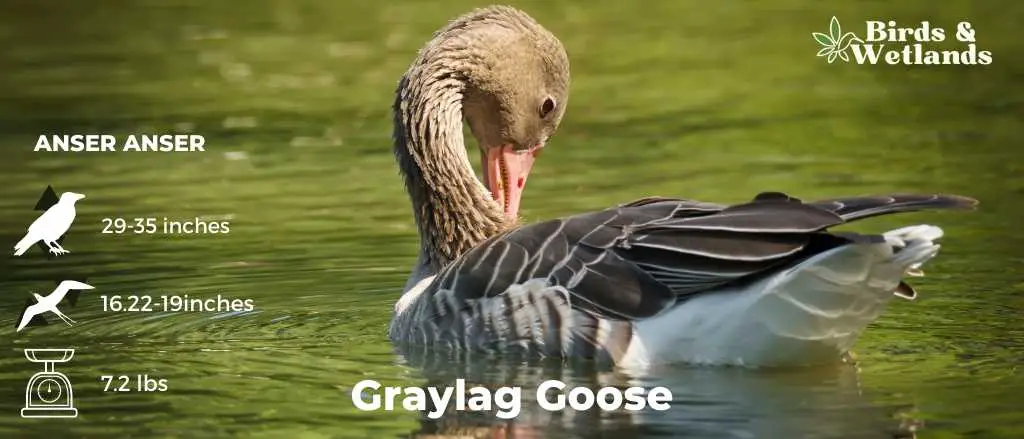The greylag goose is a large and distinctive waterfowl species throughout the Old World — Europe, Asia and Africa. It is the largest grey goose species and is considered the ancestor of many domesticated, farmyard geese.
Scientific Name: Anser anser
Length: 74 – 91 centimeters
Wingspan: 41.2 – 48 centimetres (16+1⁄4 to 19 in)
Weight: 3.3 kilograms
Greylag Goose Taxonomy
The history of greylag goose taxonomy is a rich and fascinating one. Carl Linnaeus first described the goose in 1758 and classified it as Anas anser. However, two years later, French zoologist Mathurin Jacques Brisson transferred the species to the genus Anser, which today serves as the type species for that genus.
There are two recognized subspecies of greylag goose — A. a. anser and A. a. rubrirostris. A. a. anser, also known as the western greylag goose, breeds in Iceland and northern and central Europe and the British Isles. While the A. a. rubrirostris, the eastern greylag goose, breeds in Romania, Turkey, and Russia eastwards to northeastern China. These two subspecies often intergrade with each other where their species meet.
The greylag goose has been subject to extensive domestication for thousands of years, possibly first occurring in Ancient Egypt as long as 3,000 years ago. It is considered to be among the first animals to be domesticated. As a domestic subspecies of the wild greylag geese, the domestic geese ultimately share many characteristics with feral birds.
The greylag geese remain common in agriculture, secluded lakes, river valleys, gravel pits, suburban parks, and open spaces across Europe and North America. With their long history and interesting biology, the greylag goose is undoubtedly one of the fascinating birds on Earth.
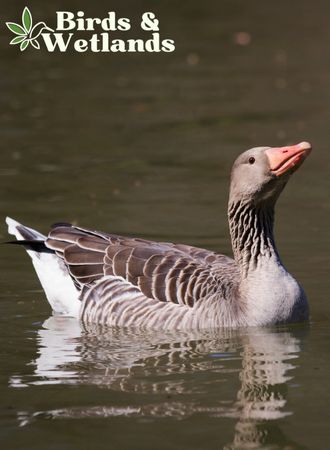
Greylag Goose Description
The greylag goose is a large, graceful bird with distinctive barred grey and white plumage, pale fringes, pink legs, an orange bill and striking white markings. It is easily identifiable in the wild due to its bulkier size and paler plumage than other grey geese.
Adult greylag geese have bulky bodies, with greyish-brown feathers covering the upper parts and creamy-white edges along the wings and tail. In addition, black flight feathers provide a dramatic contrast to the pale white underside of their wings. The heads and necks of greylag geese are greyish-brown in color, and their underbellies are white, dotted with fine grey streaks or blotches.
Meanwhile, juvenile greylag geese are similar to adult greylag geese in appearance but have darker feathers overall, with more white line bordering their upper parts. As they grow older, they will change their plumage but will keep the orange beak.
Males are larger than females in general, especially in the eastern subspecies rubirostris.
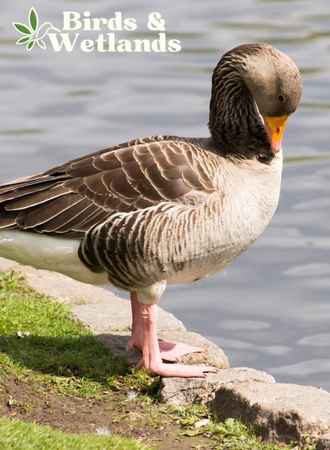
Listen to Greylag Goose
The greylag goose is known for its distinctive loud cackling call similar to that of the domestic goose. This call is typically uttered on the ground or in flight and can vary depending on the context.
In addition, individual geese appear to be able to identify other known geese by their voices, and there are various subtle variations used under different circumstances. The sound of a flock of greylag geese resembles a hound baying.
Goslings chirp or whistle lightly while adults hiss if threatened or angered by another animal.

Diet
Wild greylag geese are opportunistic foragers, feeding on various plant and animal matter depending on the season and location.
During the spring and summer months, the graylag goose primarily feeds on tubers, sea clubrush, berries, water plants such as duckweed and floating sweetgrass, as well as various types of grass, leaf matter, grains, oats, wheat, barley, buckwheat, lentils, peas, root crops like potatoes and other types of floating vegetation.
Wild geese focus on different food sources as winter approaches, such as grains, potatoes, and various vegetables. They also supplement their winter diet with small fish, worms, frogs, tadpoles, crustaceans, insects and mollusks.
What sets greylag geese apart from other geese is their ability to exploit various habitats with varying food sources. This ability allows them to thrive in diverse environments with rich and varied food sources. Whether grazing in grassland or probing into freshwater marshes to reach the roots and bulbs below ground level, greylag geese have evolved to be able tenants of the natural world.
Habitat
The wild greylag goose is a waterfowl species typically found in wet environments and semi-aquatic habitats with open countryside. These geese tend to frequent grasslands and wooded areas with tall, dense vegetation along the fringes, where they can find adequate cover while also having access to nearby open lands. They also form flocks and visit agricultural land.
In the winter, greylag geese frequent salt marshes and other swamp-like habitats, such as lakes and marshlands, where they can forage for food without having to expend too much energy.
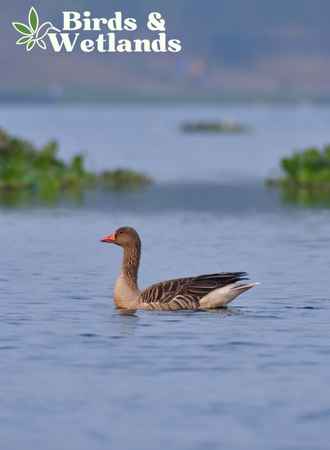
Range & Migration

Europe & Asia
The wild greylag goose is a species that has a wide distribution throughout the Palearctic region.
The A.a. anser subspecies encompasses Iceland, Norway, Sweden, Finland, the Baltic States, northern Russia, Poland, eastern Hungary, Romania, and several other European countries. Other members of this subspecies also breed in the UK, Denmark, Germany, Austria, the Czech Republic, Slovakia, and North Macedonia. The eastern race extends eastwards across a large swath of Asia to China.
European birds migrate southwards to their wintering grounds in North Africa, Middle East and other parts of the Mediterranean region. In comparison, Asian birds migrate to central and south Asia, such as Azerbaijan, Iran, Pakistan, northern India, Bangladesh and eastward to China.
North America
Two distinct segments characterize the population distribution and breeding range of greylag geese in North America. On the one hand, a much larger domestic breeds of greylag geese spends most of its time on farms, ranches, and other areas where humans live and work. These greylag geese are commonly raised for meat and eggs. In some parts of North America, the greylag geese are considered hunting trophies.
On the other hand, there is a relatively small wild population of greylag geese that resides in North America year-round. As their name suggests, these geese prefer more remote or isolated areas away from human activity. The breeding range of these wild North American greylag geese extends across much of southern Canada and parts of Alaska. Still, the wild greylag geese often migrate to lower latitudes during winter to seek warmer climates.
Nesting & Mating
Generally, the breeding season of greylag geese in the wild occurs in April to May. And the breeding territories of these geese include Europe, Asia and northern parts of Africa.
Greylag geese breed in many locations such as marshes, moors with scattered lochs, fens, peat-bogs and near lakes. The wild greylag goose is known for laying its nests on the dense ground cover of bushes, heather, dwarf shrubs, willow thickets and reeds.
The nest of the greylag goose is typically constructed from a mixture of reeds, grasses, mosses, and other plant materials, often supplemented with small feathers and down to create a warm and comfortable space for the eggs. In general, the nests are shallow cups that are highly camouflaged to blend into their surroundings and reduce the risk of predation.
Also, greylag geese are famously social birds that form large flocks and nest together in loose colonies. Greylags band together to defend their young, which helps parents defend their young by mobbing or attacking predators and chasing large birds.
After the female greylag goose lays 4 to 6 eggs, incubation typically lasts about 27-28 days. During this time, the mother greylag goose hangs out near her nests to provide warmth for the emerging chicks while the male remains on guard nearby.
Once the eggs hatch, they are precocial – meaning they can walk, eat on their own, and forage for food immediately after birth. These young greylag geese are covered in brownish-olive down on the upper parts and yellow below. They usually fledge about 50 to 60 days after hatching, although this can vary depending on temperature and food availability.
Wild greylag geese reach sexual maturity and will being to mate at 2-3 years of age.
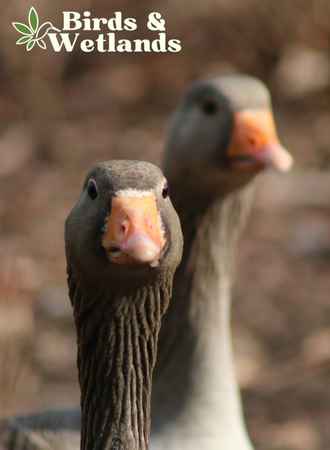
Population & Conservation Status
The Greylag Goose has been a key food source for humans since ancient times and has been widely hunted in the Northern Hemisphere across its breeding range. Currently, this goose species is not considered threatened. However, some declines have been observed in certain areas due to the loss of wetlands and hunting pressure. Additionally, these geese can cause considerable damage to agricultural crops and spread avian influenza, causing conflicts with farmers as they seek out feed.
Fortunately, several successful reintroduction efforts have taken place over the years, helping bolster populations of greylag geese in some regions. Moreover, these geese are protected in some regions. For instance, greylag geese are protected in the UK under the Wildlife and Countryside Act.
Key Takeaways
While some members of the Anser genus have black bills, greylag geese have orange legs and feet, distinguishing them from the other two genera.
Greylag geese have a wide distribution, with birds migrating southwards from the north of their range in Europe and Asia to spend the winter in warmer climates.
- Greylag geese are among the first animals to be domesticated by humans.

